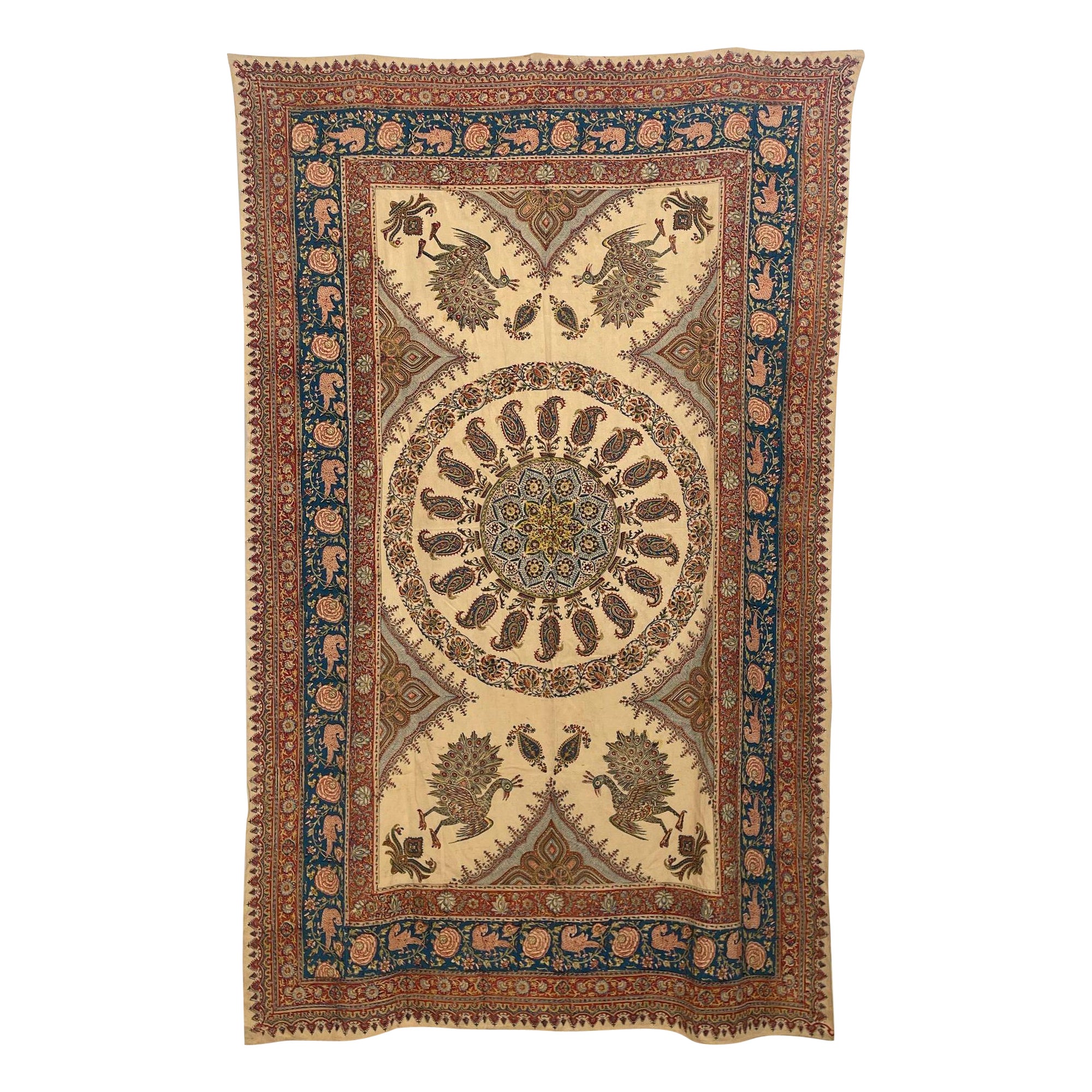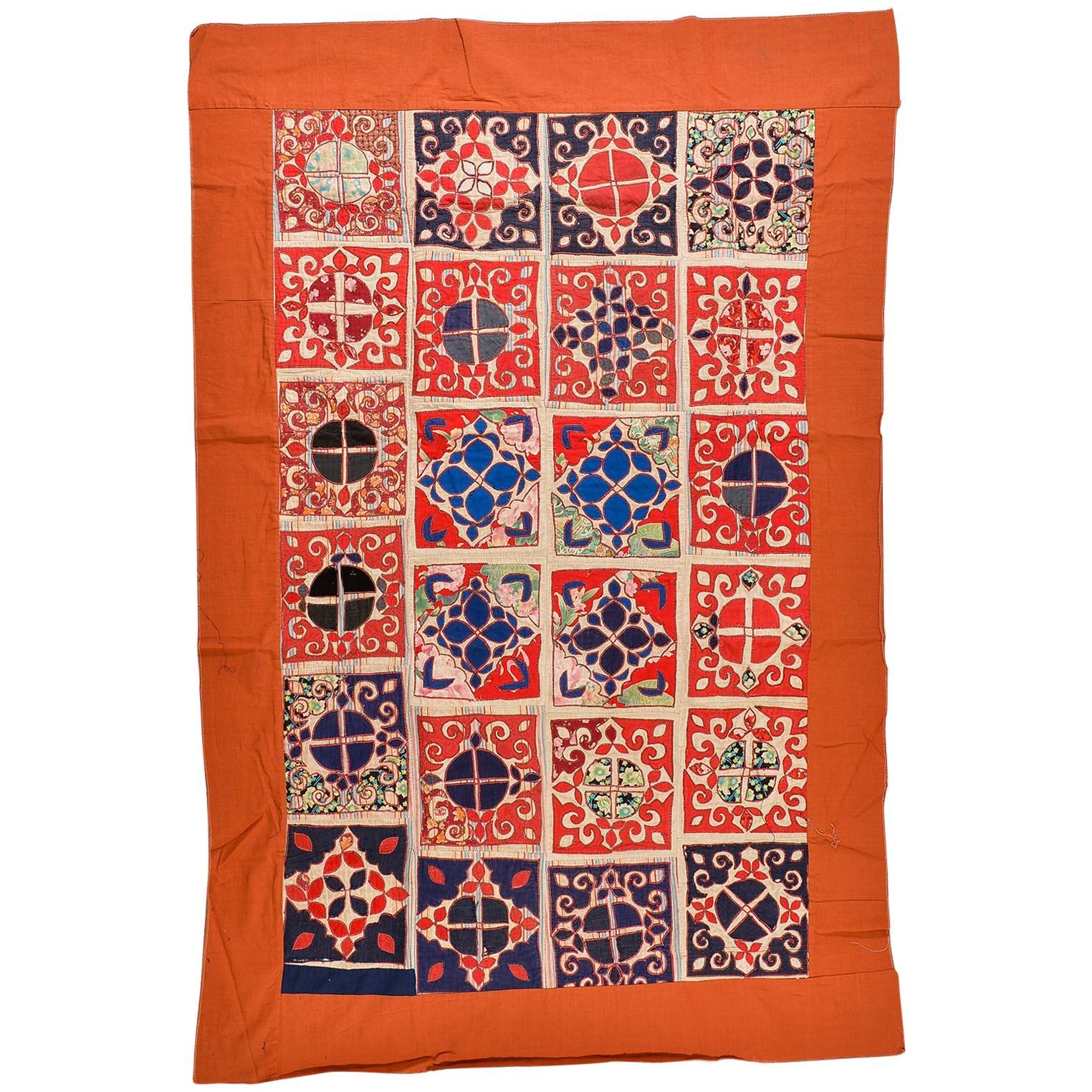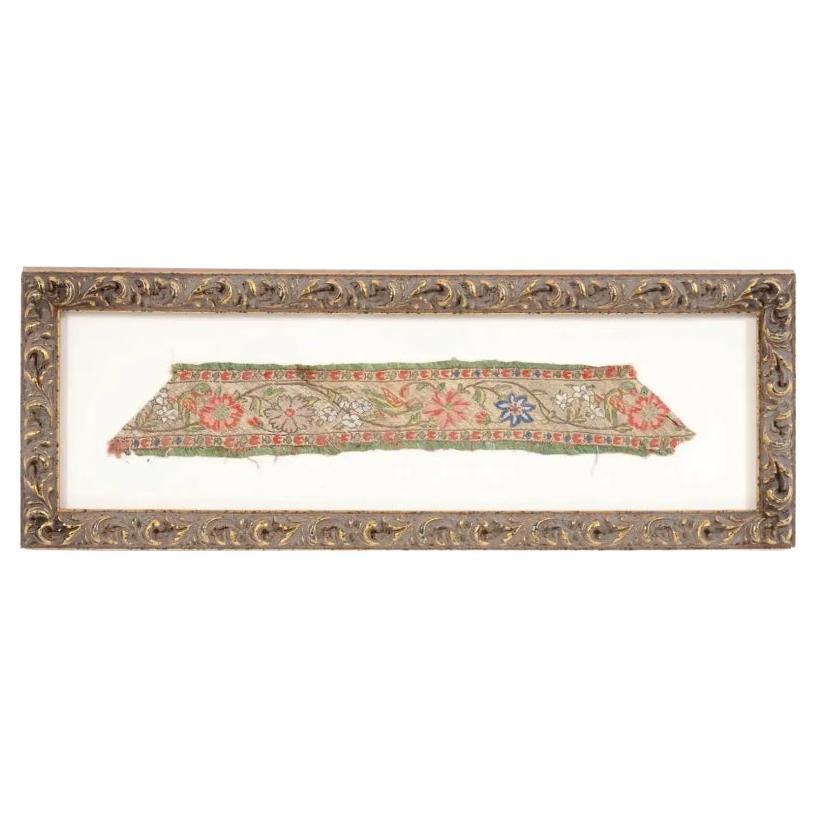Items Similar to Persian Kalamkar Hand-Blocked Tapestry Textile Isfahan
Video Loading
Want more images or videos?
Request additional images or videos from the seller
1 of 21
Persian Kalamkar Hand-Blocked Tapestry Textile Isfahan
About the Item
An absolutely gorgeous example of the traditional Antique Persian hand-blocked tapestry textile.
Persian Kalamkar (Qalamkar or Ghalamkar) woodblock print textile is from the great city of Isfahan.
Gorgeous piece with very fine work that the creator had put in to make a complex design based on paisley and birds design in the middle and a border with a repeat design featuring a man and a ladies playing music and another lady pouring wine to the host who is enjoying the music.
Hand blocked vegetable and iron oxide dyes on cotton. The fabric is printed using patterned wooden stamps.
The colors are muted, blue, red, yellow and beige linen background.
Since it is block printed the design shows only in front, the back is plain linen.
From an estate in Beverly Hills CA dated circa1920-1921.
It has hand-braided fringes at the edges.
The condition is excellent.
Dimensions: 57” x 59” not including the 1/2” fringes.
This piece is light enough to hang on the wall, or it could serve as a table covering for a special mezza table, throw over the coah or bed cover. Regardless of how you decide to use it in your home or office, it is a magnificent piece of Persian style folk art.
Ghalamkar: The Art of Hand-Printed Textiles.
Qalamkari literally “pen-workmanship,” are block-printed and hand-painted cotton textiles that are used for wall-hangings, bed-coverings, table-coverings and other functions. Kalamkari is a form of Persian woodblock printed textile that originates from Esfahan in central Iran over 400 years ago.
The art of textile printing involves the manual application of color to fabric, resulting in intricate patterns and designs. In Isfahan, Iran, this traditional craft known as Ghalamkar thrives as both an artistic expression and a prominent trade. Skilled artisans utilize engraved wooden blocks to imprint patterns onto textiles, employing durable and rigid blocks typically crafted from pear tree wood.
The process begins by immersing the textiles in river water for a full day. Subsequently, they are treated with a paste made from pomegranate peel powder, granting them a creamy hue. Within the workshop, the artist initially prints the base patterns on the fabric using a black woodblock, after which an array of vibrant woodblocks is employed to add color to the designs. The textiles are then subjected to steaming, immersed in water, and stirred in a mixture of hot water, pomegranate peel, and alizarin. Finally, they are hung to dry, securing the vivid colors onto the fabric.
Cotton is the primary material used for these textiles, though historically, natural dyes derived from plants, animals, and minerals were utilized for printing patterns. However, due to the complexities of fixing natural dyes onto fabric, chemical dyes have become the preferred choice in modern times.
The art of engraving wooden blocks holds a significant place in Isfahan's cultural heritage. Regrettably, only a handful of craftsmen continue to practice this delicate art form today. The meticulous process of engraving intricate patterns onto a wooden block poses a challenge, requiring immense skill and precision.
The patterns found in Ghalamkar textiles are diverse and often draw inspiration from Persian miniature paintings. The desirability of the patterns increases with the level of talent and expertise demonstrated by the artist. Some common themes include historical landmarks, animals, miniatures, musicians, flowers and trees, depictions of renowned poets, ancient tales from Persian literature, and scenes depicting lovers.
The art of Ghalamkar textile printing has persisted in Isfahan since the Safavid dynasty and continues to flourish in the present day, embodying a rich legacy of craftsmanship and creativity.
Rugs and textiles possess a remarkable ability to forge connections with us, becoming cherished companions as we spend time appreciating them as works of art. It is awe-inspiring to contemplate the boundless talent and creativity of the individuals who crafted these pieces. Both men and women push their limits to fashion these marvelous objects, intended to captivate our eyes, touch our hearts, and stimulate our minds.
As passionate seekers of collectors who share our deep appreciation for the treasures we encounter during our travels, we derive immense joy from discovering and acquiring these objects, many of which have graced our personal collection. However, there comes a time when we must pass them on to new owners, allowing them to embark on their own adventures. We sincerely hope that as you spend time with and study these magnificent items, you will also come to cherish the love and individuality imbued by the talented artists who brought them to life.
Calico: The Ancient Craft of Iranian Fabric Painting
Calico, an ancient craft of Iran, enjoyed centuries of fame and prominence. Its popularity soared during the Mongol era in Iran when fabric painting, including Chinese painted fabric, gained significant market shares with the support of Mongol chiefs. In an effort to tap into this market, Iranians devised their own distinct painted fabric known as Calico.
Ghalamkar, also spelled as Qalamkaar or Qalamkar, is a type of textile printing that produces patterned Iranian fabric. This method involves the use of patterned wooden stamps to print designs onto the fabric. In India, a similar technique is known as Kalamkari, which encompasses both hand-painted and block-printed cotton textiles.
The term "Ghalamkar" originates from the Persian words "ghalam" (pen) and "kari" (craftsmanship), signifying the art of drawing with a pen. Additionally, the term "čīt" refers to cotton cloth adorned with block-printed or painted designs in multiple colors. This term made its way into the English language as "chintz," now commonly used to describe any cotton or linen furnishing fabric printed with floral designs in fast colors.
- Dimensions:Height: 59 in (149.86 cm)Width: 57 in (144.78 cm)Depth: 0.1 in (2.54 mm)
- Style:Islamic (In the Style Of)
- Materials and Techniques:
- Place of Origin:
- Period:
- Date of Manufacture:1920
- Condition:
- Seller Location:North Hollywood, CA
- Reference Number:
About the Seller
5.0
Platinum Seller
These expertly vetted sellers are 1stDibs' most experienced sellers and are rated highest by our customers.
1stDibs seller since 2011
2,649 sales on 1stDibs
Typical response time: 1 hour
- ShippingRetrieving quote...Ships From: North Hollywood, CA
- Return PolicyA return for this item may be initiated within 7 days of delivery.
More From This SellerView All
- Large Isfahan Ghalamkar Persian Paisley Textile Block Printed 1950sLocated in North Hollywood, CAVintage large Isfahan block printed cotton hand printed fabric bedspread or wall Hanging Textile or table cloth. Persian Paisley Kalamkari textile hand b...Category
Mid-20th Century Asian Islamic Textiles
MaterialsCotton
- Embroidered Textile Tapestry Bed Spread from IndiaLocated in North Hollywood, CALarge textile, tapestry or bed cover, embroidered and mirrored, black back ground with safran and white floral decor. Batik printed and embroidered. Great as a wall hanging or bed co...Category
20th Century Indian Moorish Quilts and Blankets
MaterialsCotton
- Paisley Kalamkari Textile from IndiaLocated in North Hollywood, CA1930s Paisley Kalamkari textile from India. Hand blocked vegetable and iron oxide dyes on cotton. The fabric is printed using patterned wooden st...Category
Early 20th Century Indian Islamic Quilts and Blankets
MaterialsCotton
- Mughal Hand Embroidered Metal Threaded Tapestry from Rajasthan, IndiaBy RajhastaniLocated in North Hollywood, CAHand embroidered and quilted textile from North India. Mughal silk and metal threaded tapestry. Backed with black linen. Fanciful Asian folk designs this d...Category
20th Century Indian Anglo Raj Textiles
MaterialsCotton
- Hand Embroidered Mughal silk and metal threaded tapestry, IndiaBy RajhastaniLocated in North Hollywood, CAHand embroidered and quilted textile from North India. Large Mughal silk and metal threaded tapestry Fanciful Asian folk designs this distinctive quilt wor...Category
20th Century Indian Anglo Raj Textiles
MaterialsSilk
- 19th Century Islamic Art Ottoman Metallic Threads Arched Fragment TextileLocated in North Hollywood, CA19th Century Islamic Art, Ottoman Moorish Metallic Threads Embroidered Arched Textile. Collectible Museum quality antique textile fragment probably part of a wall hanging or mirror cloth. Early 19th century antique Islamic Ottoman Empire style embroidered silk and metal thread panel. Compositions in Moorish 8 pointed star design medallions surrounded by scrolling vine, lined, scattered losses and loose threads to silk. Antique Oriental Byzantine textile depicting embroidered flowers depicting branches filled-in with silk floss threads creating an intricate embroidered pattern. On two of the corners, the antique textile panel is embellished with bands of blue silk rushing framed by with antique metallic trims, this dramatic embroidered of meandering botanical's are done in earthy colors and embroidered on natural linen. An antique Ottoman Empire textile decorative and historical artifact. "Ottoman silk textiles are among the most elegant textiles produced in the Islamic word. Executed in a range of woven techniques including satin and velvet, these silks were produced for use both within the Ottoman Empire and for export to Europe and the Middle East, where they were considered among the most prized luxury objects. Most Ottoman silks produced for use within the Empire were used either for garments or furnishings." Condensed from: Nazanin Hedayat Munroe. Department of Islamic Art, the Metropolitan Museum of Art. This antique Islamic Art...Category
Antique Late 19th Century Turkish Islamic Textiles
MaterialsMetallic Thread
You May Also Like
- Turkoman Patchwork Textile, Tapestry or Armchair UpholsteryLocated in Alessandria, PiemonteNice Turkoman patchwork textile with light colors, suitable for tapestry, headboard, armchair upholstery. They are all embroideries applied on a rein...Category
1990s Turkmen Folk Art Tapestries
MaterialsCotton
- Antique Persian Safavid Silk Textile FragmentLocated in New York, NYAn antique Persian fragment of textile tapestry. Late Safavid dynasty, 18th century. Ilsamic calligraphy against the blue background. Canvas mat, gold...Category
Antique 18th Century Unknown Textiles
MaterialsTextile
- Antique Persian Safavid Silk Textile FragmentLocated in New York, NYAn antique Persian fragment of textile tapestry. Late Safavid dynasty, 18th century. Floral pattern in red and green. Canvas mat, golden frame. Collec...Category
Antique 18th Century Unknown Textiles
MaterialsTextile
- Antique Persian Safavid Silk Textile FragmentLocated in New York, NYAn antique Persian fragment of textile tapestry. Late Safavid dynasty, 18th century. Horses, birds and flowers pattern in blue. Canvas mat, golden fra...Category
Antique 18th Century Unknown Textiles
MaterialsTextile
- Large Azerbaijan Jajim Textile, Handwoven Flat-Woven Tapestry RugLocated in Hampshire, GBOrange, red and black make up the simple geometric stripe design in this Jajim, woven by hand in Azerbaijan. The traditional stripe design and the simple color palette in this piece ...Category
Antique Early 19th Century Azerbaijani Country Textiles
MaterialsNatural Fiber, Organic Material, Cotton, Wool
- 2 Korean Metallic Silk Embroidered Peacock Dragon Textile Tapestry 83"Located in Dayton, OHTwo vintage Korean textile tapestries. Made of silk featuring metallic gold embroidery with medallions, peacocks and dragons. One purple, one green. Wall hanging. Tablecloth. Di...Category
Late 20th Century Chinoiserie Textiles
MaterialsSilk
Recently Viewed
View AllMore Ways To Browse
Chinese Day Bed
Antique Iron Day Bed
Woodblock Fabric
Batik Tulis
Chinese Gold Jewelry Online Shop
Hermes Circe
Karen Sgaw
Rare Silk Pillows By Ferghana
Round Tablecloth Fringe
Tampella Finland
Yves Berger
Vintage Ikat Indonesia
Frame Antique Chinese Embroidered Robe
Silk Antique Chinese Skirt
Kimono Ceremonial Vintage Silk
Antique Japanese Obi
Japanese Fukusa
Suzani Table Runner





